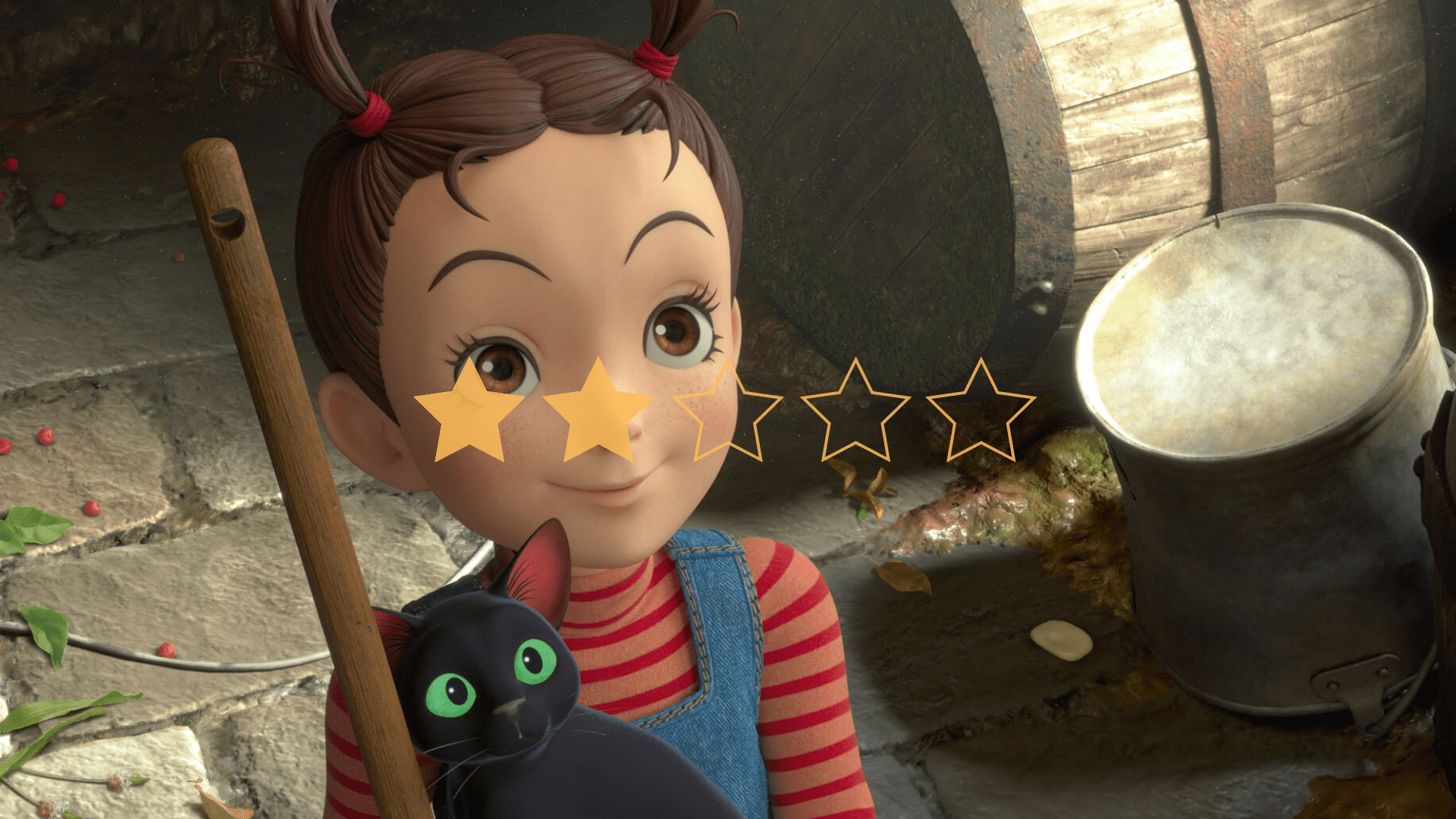★★✰✰✰
Though charming, Earwig and the Witch doesn’t meet the high expectations we have for the studio who made it.
Earwig and the Witch, the first CG animated film from Studio Ghibli, has been overrun with negative reviews almost from its very announcement. For many, the decision to trade in the studio’s elegant hand-drawn animation for computer generated imagery is a baffling one, with Ghibli sticking to more traditional animation methods for so long. This is, of course, not entirely true and Earwig and the Witch is far from the Studio’s first use of CG animation (that Ghibli has used CG animation for most of it output since Princess Mononoke is guarded as a dirty little secret). Earwig’s visuals are, however, a sign that this film is a very clear departure from the studio’s usual output and to very middling results.
Ghibli films are known for their rich yet unconventional storytelling; threadbare plots often hide complex characterisation and an unblinking interrogation of mature themes. The works of veteran animators Hayao Miyazaki and Isao Takahata have come to represent Ghibli, but the latest from Hayao’s son Gorō Miyazaki arrives with a determination to challenge expectations through a celebration of juvenile rebellion. Earwig’s plot is threadbare, just like some of the studio’s best—but the film fails to infuse the plot with any depth beyond this.
We follow 12-year-old Erica, a witch orphaned from a young age with a penchant for mischief. Her real name alludes to her rebellious nature: Earwig, after the bug that burrows in your ear. One day, Erica is adopted by an eccentric couple consisting of a demon known as The Mandrake and, as the title suggests, a witch. Within her new home, Erica is excited to learn magic as a witch’s apprentice. Instead, however, she finds herself being treated as a servant, with her days spent cleaning and counting out ingredients. As you can expect, shenanigans ensue as Earwig tries to break free from this mundane existence.
There’s clearly contextual relevance to be found in Gorō directing a film about a child eager to be taught the art of magic from a parental figure, but the film is by no means an exercise in bitterness. Instead, what we have is an endearing film aimed at very young children, and when watched in this context (as I did, being one of two adults in the screening) it’s hard to fault the film’s charm.
But when you dig a little deeper as the 3D visuals invite us to do, the film’s flaws are numerous. It would be unfair to expect Ghibli’s first effort at a fully CG film to be on par with other industry giants, despite their unofficial title of ‘The Pixar of the East.’ There is certainly some joy to be had seeing Ghibli’s art style translated to a 3D space, and some of the designs are truly impressive (The Mandrake in particular). However, as soon as characters start to move, the animation is revealed to be oppressively static. Lighting fails to bend around objects, giving everything a rather flat feel. Hair seems to hold immovably in the air, despite all kinds of character movement. It would be enough to call to mind There’s Something About Mary if the audience wasn’t too young to make the connection.
Read more: ‘Spirited Away’ To Be Adapted For The Stage
Food plays a vital role in Earwig’s plot, which makes it even more disappointing that Ghibli’s mouth-watering depiction of meals is nowhere to be found here. Especially since the plat du jour this time is pub grub—who better to give Britain’s much derided food culture a little more prestige than Ghibli? Unfortunately, much of the food is implied rather than served up before us. Earwig’s orphanage supposedly serves the best shepherd’s pie in ‘the whole world’, at least that’s what we’re told several times in the film. When the pie does make an appearance, the film is edited so that we find ourselves looking more at Erica’s reaction than the food itself. It’s almost as if the film itself is embarrassed about how unappealing the dish looks, and that is when you know there’s a problem.
On top of all this, the English dub is yet another victim to the animation, with CG unavoidably lending itself rather poorly to the practice of dubbing. To make matters worse, much of the English cast fails to deliver engaging performances, with their deliveries sounding as plastic as the animation looks. Richard E. Grant shows promise in his role as The Mandrake, but the script never really gives him the chance to shine. Instead, he mumbles and murmurs commands. Even in instances when his rage explodes, we just get louder mumbling. The sole exception to this is Taylor Paige Henderson as Earwig: Henderson plays the bratty witch with such charm and energy that it’s hard not to find her endearing. In fact, Earwig and the Witch may just feature one of my favourite Ghibli protagonists in recent memory—it’s just a shame that she’s not in a better film.
The Verdict
Ghibli’s latest is an endearing but forgettable affair, even for those willing to embrace the CG animation. There’s enough charm to be found here to warrant a watch, but there’s little to come back for.
Words by Jake Abatan
Support The Indiependent
We’re trying to raise £200 a month to help cover our operational costs. This includes our ‘Writer of the Month’ awards, where we recognise the amazing work produced by our contributor team. If you’ve enjoyed reading our site, we’d really appreciate it if you could donate to The Indiependent. Whether you can give £1 or £10, you’d be making a huge difference to our small team.

